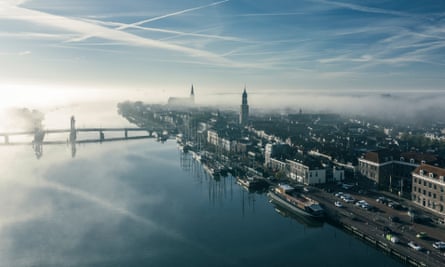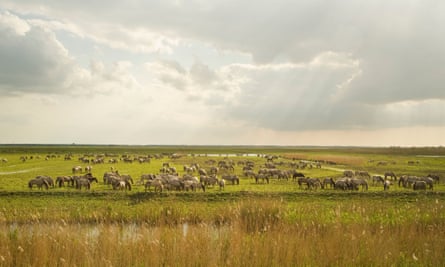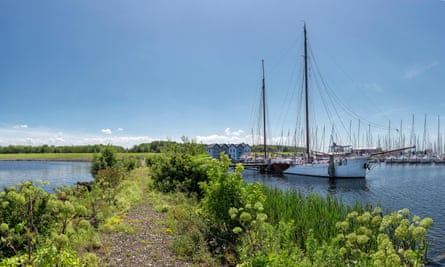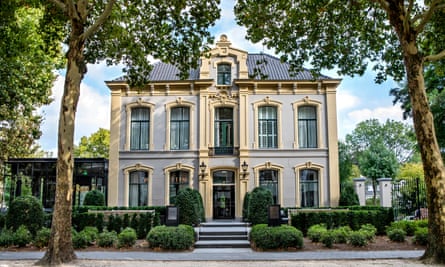There are train journeys where one just gazes at hills rolling by beyond the carriage window. I love such routes, be they in the Alps, Iberia or the Balkans. Things are different in the Netherlands, where pancake-flat landscapes dominate. Yet even in the flatlands there is often visual drama. The rail routes skirting Dutch heathlands around Apeldoorn are wonderful. And there is a subtle beauty, especially at low sun angles, to the secondary railways which follow the River IJssel downstream from Zutphen to Zwolle.
Zwolle makes a fine base for exploring the north-east Netherlands, all the more so if your budget extends to a night or two at the excellent Ter Borch in Zwolle (doubles from €175) right by the station. From Zwolle, one might strike north to Friesland or take the short branch line out to the pretty town of Kampen. Or explore the Netherlands’ newest mainline railway (completed in 2012), the Hanzelijn, which runs west from Zwolle through the province of Flevoland. The Hanzelijn opened in 2012 and traverses a land of far horizons, much of it below sea level. All thanks to the far-sighted ingenuity of engineer Cornelis Lely (1854-1929) and the hard work of Dutch dykers and drainers who have created an entire new province from the sea.

There are two fast trains each hour leaving Zwolle on the Hanzelijn, all running via Lelystad to Almere and then on to Schiphol airport and Den Haag. There are also two slow trains each hour that run only as far as Lelystad, which is the capital of Flevoland. The railway’s name pays homage to the region’s historic Hanseatic connections. For example, Zwolle prospered from the 13th century through the trade and commerce nurtured by the Hanseatic League.
New land for new communities

Zwolle is a very welcoming town, the sort of place that is hard to leave. So it is a little reluctantly that I make my way to the station to catch a regional train along the Hanzelijn to Lelystad. Within minutes, our empty train is cruising across a striking red bridge over the River IJssel. The bridge captures Dutch commitment to climate-friendly travel: a double-track rail route with ample space for cyclists and pedestrians, but no provision for cars. Away to the north, the skyline of Kampen, another community that makes much of its Hanseatic history, is dominated by a great Gothic church.
The whole idea of building a railway from Zwolle across newly reclaimed polders was contentious, and the route’s planners had to rise to myriad environmental challenges. We plunge into a long tunnel under the fragile Drontermeer marshes, along the way crossing the border into Flevoland. Is it not a wondrous thing that so much of this railway crosses land that a century ago was below the waves?
Wildlife and wilderness

There are wistfully beautiful water meadows with long lines of poplars marching to the horizon. There are shining new communities such as Dronten and Lelystad, both founded in the 1960s, the latter of course named after Cornelis Lely. And there is also a real dash of wilderness, an all-too-rare commodity in the Netherlands, for some of these lands newly claimed from the sea are not yet entirely tamed.
“You need to look out for the Big Five,” says a freckle-faced woman on the train, who explains she is working on the ecology of polder landscapes. Lions and elephants seem unlikely, but I discover that this part of Flevoland is rich in wildlife possibilities. The Big Five in these parts are sea eagles, heck cattle (which look strangely like bison), wild konik ponies, foxes and red deer.
So take a tip. Next time you arrive in the Netherlands, don’t linger in the big cities or hop on the fast train to another country. Make time to explore lesser cities like Zwolle. Take the slow train along the Hanzelijn via Lelystad to Zwolle to catch a glimpse of how Dutch enthusiasm for taming the sea has shaped the development of new landscapes and communities.
On two journeys, respectively in June and November this year, I have thoroughly explored the Hanzelijn, stopping off at stations along the route. I discovered striking modern architecture in Lelystad, much of it set amid watery, green landscapes. And also saw challenges facing a community that developed very quickly in the 70s and now, like some British new towns, must reinvent itself for a younger generation.
after newsletter promotion
But the biggest surprise of the Hanzelijn is the engagement with nature. I walked out from Lelystad to Oostvaardersplassen where on the reedy south flank of the IJsselmeer one of Europe’s greatest rewilding projects is taking place. Within the compass of just an hour or two, I slipped from modern, urban Europe into a wilderness of water meadows and young woodland. It’s a place for buzzards and barnacle geese, reed bunting and sedge warbler.

Those less inclined to explore on foot still get good views of these new landscapes on the comfortable trains that run over the Hanzelijn. The railway cuts through the youngest national park in the Netherlands. The Nieuw Land national park, at 112 square miles the second largest in the country, protects and preserves the natural landscapes of the territory reclaimed from the sea over the last century by creating a series of dykes that separated the Zuider Zee from the North Sea. A leading advocate of that ambitious programme of flood prevention and land reclamation was Lely, himself an enthusiastic promoter of railways. His spirit must surely smile benignly on the Hanzelijn, which connects Flevoland communities with the rest of the Netherlands.
Travel details

Zwolle makes an excellent first stop in the Netherlands. Fast trains run every 30 minutes from Schiphol airport via the Hanzelijn directly to Zwolle taking 69 minutes. There is also a half-hourly connection from Amsterdam Centraal to Zwolle, with one easy change of train at Almere Centrum and an overall travel time of 65 minutes. Frequent trains run the length of the Hanzelijn from Almere to Zwolle. The one-way fare, bought at the station ticket machine before departure, is €17.90. A NS Dagkaart for €58.80 allows unlimited rail travel in the Netherlands for a day. Or use Interrail, where a global pass allows unlimited travel in over 30 countries. Nicky Gardner stayed on both visits at the Ter Borch in Zwolle, a boutique hotel housed in a gracious villa, where doubles start at €175 B&B.
Nicky Gardner is co-author of Europe by Rail: the Definitive Guide. The 17th edition is available from the Guardian Bookshop.







